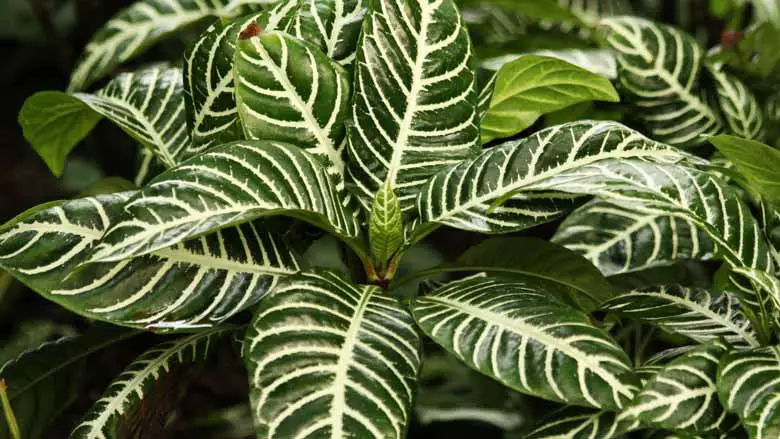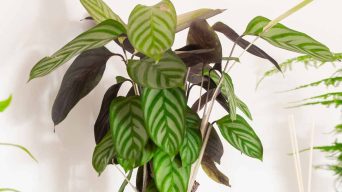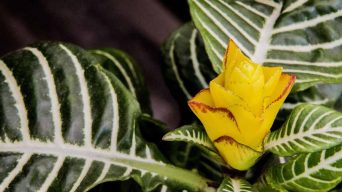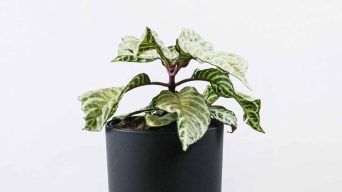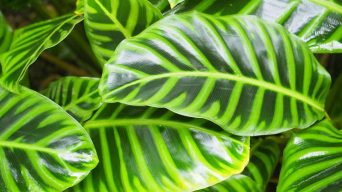Aphelandra squarrosa, or zebra plant, is a popular houseplant known for its bold, striped leaves.
These tropical plants are native to Brazil and thrive in warm, humid environments.
While zebra plants are relatively low-maintenance, their leaves may droop for various reasons, including too much or too little water, not enough light, or pests.
This article will explore 7 common causes of drooping zebra plant leaves and provide solutions to get your plant looking healthy again.
Why Are My Zebra Plant Leaves Drooping?
Zebra plants are tolerant of different growing conditions, but their leaves will droop if they do not get the proper care.
You must first identify the cause of the zebra plant drooping leaves to give the best treatment.
The most common reasons for zebra plant leaves drooping are:
1. Underwatering
When zebra plants don’t get enough water, their leaves start drooping.
This is because the plant is not getting the moisture it needs to support its leaves.
Zebra plants need to be watered about once a week or when the top inch of soil is dry to the touch.
How To Tell If Your Zebra Plant Is Underwatered
There are a few telltale signs that your zebra plant is not getting enough water, including:
- Dry, brown patches on the leaves
- Leaves that are wilting or drooping
- Soil that is dry to the touch
- Slow growth
How To Fix An Underwatered Zebra Plant
If your zebra plant is underwatered, the best solution is to water it more frequently.
Make sure to water the plant until the potting soil is moist all the way through and allow the excess water to drain away.
The best way to water a zebra plant is to use lukewarm water, mist the leaves, and water the soil.
If the leaves are wilted, you can also soak the plant in lukewarm water for about 15 minutes.
2. Overwatering
While underwatering is a common problem, overwatering can also cause zebra plant leaves to droop.
Overwatering is often caused by incorrect watering habits, such as watering too often or using too much water.
This can lead to the plant’s roots being waterlogged, which prevents them from getting the oxygen they need to function correctly.
How To Tell If Your Zebra Plant Is Overwatered
There are a few signs that your zebra plant is getting too much water, including:
- Soil that is soggy or wet
- Leaves that are wilting or drooping
- Yellow or brown leaves
- Slow growth
- Stunted leaves
- Root rot
How To Fix An Overwatered Zebra Plant
If your zebra plant is overwatered, the best solution is to water it less often.
Allow the top inch of soil to dry out completely before watering the plant again.
Consider repotting the plant using a well-draining potting mix to enhance drainage as an additional measure.
If the roots are waterlogged, you may need to remove them from the pot and replant them in dry soil.
3. Not Enough Light
Zebra plants need bright, indirect light to thrive.
If they do not get enough light, their leaves will start drooping.
Zebra plants need at least 4 hours of indirect sunlight per day.
How To Tell If Your Zebra Plant Is Not Getting Enough Light
There are a few signs that your zebra plant is not getting enough light, including:
- Leaves that are pale or yellow
- Slow growth
- Leggy stems
How To Fix A Zebra Plant That Is Not Getting Enough Light
If your zebra plant is not getting enough light, moving it to a brighter location is best.
Zebra plants can tolerate direct sunlight for short periods but must be acclimated slowly to prevent leaf scorch.
Start by moving the plant to a location that receives indirect sunlight for 4 hours per day and gradually increase the amount of light it is getting.
A west- or east-facing window is a good option.
4. Low Humidity
Zebra plants need high humidity to thrive.
If the air is too dry, their leaves will start to droop.
The ideal humidity level for zebra plants is 50-60%.
How To Tell If The Air Is Too Dry For Your Zebra Plant
There are a few signs that the air is too dry for your zebra plant, including:
- Dry, brown patches on the leaves
- Crispy or wilted leaves
- Slow growth
How To Increase The Humidity Around Your Zebra Plant
If the air around your zebra plant is too dry, you can do a few things to increase the humidity.
- Place the plant on a pebble tray: Fill a tray with pebbles and water and place it underneath the pot. This will help to increase the humidity around the plant.
- Use a humidifier: A humidifier will help to add moisture to the air and improve the humidity around your zebra plant.
- Group plants together: Grouping plants together will create a more humid microclimate than the surrounding area.
- Mist the leaves: Misting the leaves with water will help to increase the humidity around the plant.
5. Temperature Stress
Zebra plants do best in warm, humid environments.
If the temperature is too cold or too hot, their leaves will start to droop.
The ideal temperature for zebra plants is 60-85°F (16-29°C).
How To Tell If The Temperature Is Too Cold Or Too Hot For Your Zebra Plant
There are a few signs that the temperature is too cold or too hot for your zebra plant, including:
- Leaves that are wilting or drooping
- Brown or yellow leaves
- Slow growth
- Flower buds falling off
- Flowers that are wilted or discolored
How To Fix A Zebra Plant That Is Stressed From Temperature
If your zebra plant is stressed from the temperature, the best solution is to move it to a more suitable location.
Zebra plants prefer warm, humid environments, so moving it to a spot that is out of direct sunlight and has higher humidity will help.
Keep the plant away from drafts, heaters, and air conditioners to prevent further stress.
6. Pest infestation
Zebra plants are susceptible to various pests, including mealybugs, spider mites, and scale insects.
Mealybugs are tiny, white pests that feed on the sap of plants.
Spider mites are small, red spider-like creatures that spin webs on the leaves of plants.
Scale insects are little, hard-bodied pests that attach themselves to plant leaves and suck their sap out.
All of these pests can cause zebra plant leaves to droop.
How To Tell If Your Zebra Plant Has A Pest Infestation
There are a few signs that your zebra plant has a pest infestation, including:
- Leaves that are wilting or drooping
- Yellow or brown leaves
- Sticky leaves
- White powdery substance on the leaves
- Webbing on the leaves
How To Get Rid Of Pests On Your Zebra Plant
If your zebra plant has pests, you can do a few things to get rid of them.
- Use insecticidal soap: Insecticidal soap is a safe and effective way to get rid of pests on zebra plants. Apply the soap to the affected leaves and wash it off after a few hours.
- Use neem oil: Neem oil is a natural pesticide used to get rid of pests on zebra plants. Apply the oil to the affected leaves and wash it off after a few hours.
- Use rubbing alcohol: Rubbing alcohol will kill pests on contact. Apply it to the affected leaves with a cotton ball and wash it off after a few hours.
7. Transplant Shock
Transplant shock is a common problem that can cause zebra plant leaves to droop.
It occurs when a plant is moved from one location to another, and the roots are disturbed. This can cause the leaves to wilt and turn brown.
How To Tell If Your Zebra Plant Is In Transplant Shock
There are a few signs that your zebra plant is in transplant shock, including:
- Leaves that are wilting or drooping
- Brown or yellow leaves
- Slow growth
How To Fix A Zebra Plant In Transplant Shock
If your zebra plant is in transplant shock, the best thing you can do is to give it time to recover.
Keep the plant in a warm, humid environment and avoid fertilizing it until it has recovered.
Once the plant has recovered, you can start fertilizing it according to the manufacturer’s instructions.
How To Prevent Zebra Plant Leaves Drooping
To keep your zebra plant looking its best, you’ll need to take measures to prevent drooping leaves.
Here are a few tips:
- Make sure the plant is getting enough light. Zebra plants need bright indirect sunlight to thrive. If the leaves are drooping, it could be a sign that the plant isn’t getting enough light.
- Water the plant regularly. Zebra plants need to be watered about once a week or when the soil is dry to the touch. Over-watering can cause the leaves to droop, so be sure not to water too often.
- Use a well-draining pot. Using a pot with drainage holes is essential to prevent the roots from sitting in water. A pot that doesn’t drain well can cause the leaves to droop.
- Fertilize monthly. Zebra plants must be fertilized about once a month during the growing season. Use a balanced fertilizer to prevent leaf droop.
- Prune regularly. Zebra plants must be pruned periodically to encourage new growth and prevent the zebra plant from becoming leggy.
- Avoid drafts. Zebra plants don’t like drafts, so keep them away from windows or doors that open often.
- Check the humidity. Zebra plants prefer a humid environment, so the leaves may droop if the air is too dry.
- Raise the temperature. Zebra plants prefer a warm environment, so the leaves may droop if the room is too cold.
- Get rid of pests. Zebra plants are susceptible to pests, such as spider mites and mealybugs. If the plant is infested, the leaves will droop.
- Treat diseases. Zebra plants are also susceptible to diseases like powdery mildew and leaf spot. If the plant has a disease, the leaves will droop.
If you take these measures to prevent leaf droop, your zebra plant should stay healthy and happy.
Final Thoughts
Zebra plant care is relatively easy, but there are a few things you need to do to keep the plant healthy.
Droopy leaves are usually a sign that something is wrong, so check the plant carefully if the leaves start to droop.
With proper care, your zebra plant will thrive and provide you with beautiful foliage for years to come.

